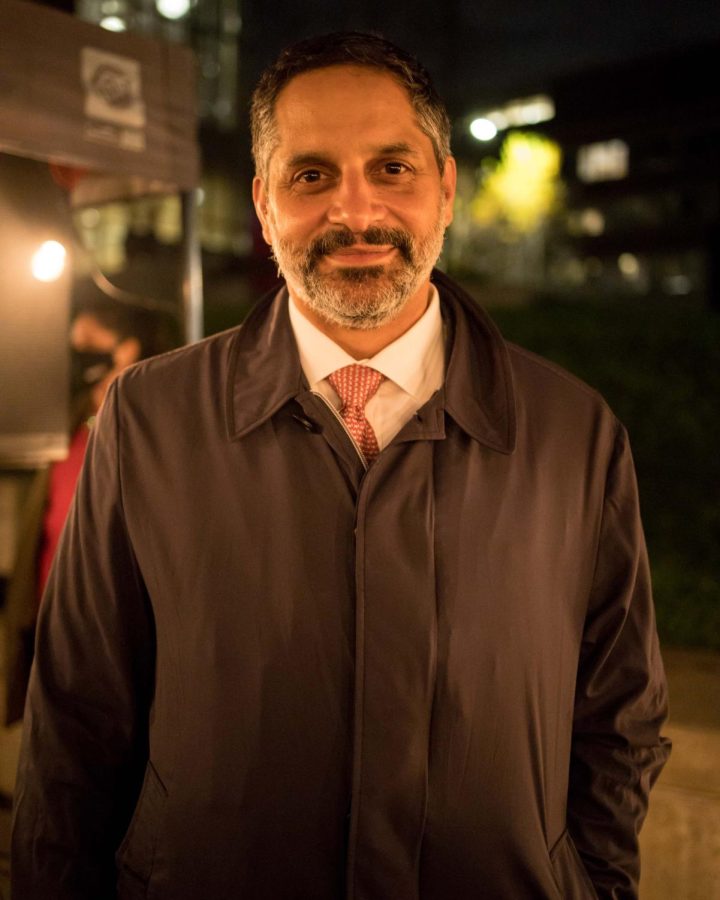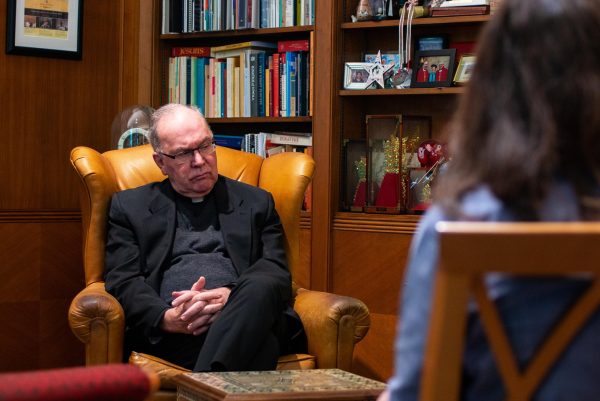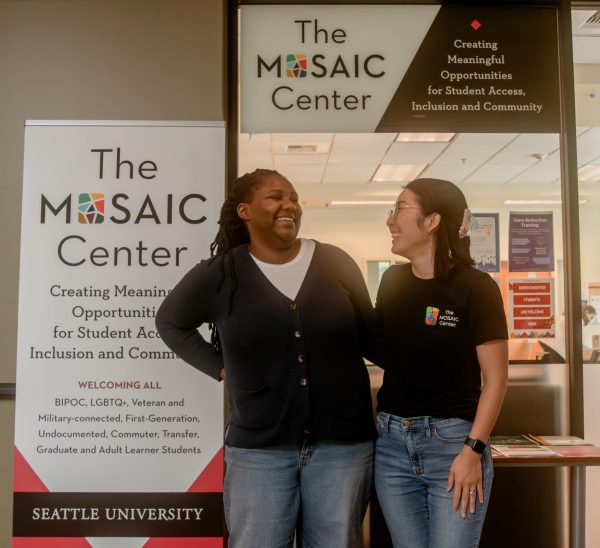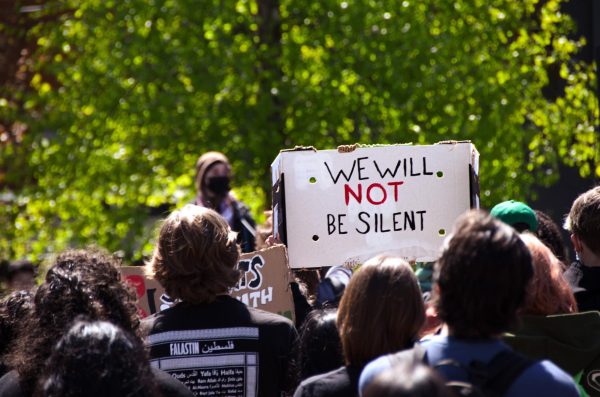The Peñalver Effect: Seattle University’s Administrative Shake-Up
During his first full year at Seattle University, President Eduardo Peñalver made key changes in leadership positions and reimagined the university’s Strategic Direction. Celebrating a year at Seattle U this past summer, Peñalver has made an impact from the moment he joined the Redhawks. He hired new faces for leadership roles across campus, oversaw the opening of the Sinegal Center for Science and Engineering, attended Seattle U events at Climate Pledge Arena and welcomed new students, faculty and staff to the Redhawk family. Peñalver is the first Latino president of Seattle U, as well as the first layperson to assume the position.
The 2021-2022 academic year saw many changes in administrative leadership positions on campus. In many of his presentations across campus, Peñalver shared his vision of Seattle U, “progressive, Jesuit and Catholic.” Peñalver reaffirmed his commitment to this vision through the changes he has made to the university, including the creation of the Vice President for Mission Integration on campus. Catherine Punsalan-Manlimos began her work in this position August 2022.
Three of Seattle U’s major colleges have also had changes in deans over the past year. Amit Shukla assumed the position of dean of the college of science and engineering, Cynthia Dillard is the new dean of the college of education and Anthony Varona is the new dean of the law school.
Provost Shane Martin noted that this administrative shake-up is ongoing.
“The Dean of the College of Nursing Kristen Swanson announced at the end of the [last] academic year that this academic year would be her last, and that she would be retiring as dean. So we will be doing a dean search for our College of Nursing. That’ll be four deans in just two and a half years,” Martin said.
The change in top-level administrators hasn’t only changed the leadership style of the university to reflect the new president’s outlook, but also ushers in a new level of diversity in positions of strategic significance.
“Among the values of Seattle University is our commitment to diversity, equity and inclusion. I’m really pleased to say that the three vice president searches and the three dean searches all yielded outstanding leaders of color who will bring different perspectives and will help to diversify the senior leadership at the university,” Martin said.
Aside from taking action through changing leadership on campus, Peñalver has set his focus on the long term project of implementing the university’s Reigniting Our Strategic Directions program, especially as students, faculty and staff continue to navigate the COVID-19 pandemic.
Peñalver assumed the Seattle U presidency after President Fr. Stephen Sundborg, S.J. left his position of 24 years. Immediately upon starting this role, he reviewed the original Strategic Directions plan, originally implemented Jan. 2020. Peñalver updated the plan to be more inclusive of the current state of the university given the pandemic, titling it Reigniting Our Strategic Directions. Afterwards, he held community forums to receive feedback on the Strategic Directions plan.
Chief Financial Officer of Seattle U Wilson Garone offered a positive review of Peñalver’s first year, and emphasized the impact of the new strategic direction of the university.
“The transition to Peñalver is going fantastic. He has put a lot of energy into designing the strategic direction for us, with a focus on how we’re going to grow, which is quite important. He’s also been very busy with all of the personnel changes that have happened,” Garone said.
‘Reigniting Our Strategic Directions’ is continuing this year and is past the initial goal writing stages. It gives the president and provost’s offices the chance to influence the long-term direction of the university. The provost’s office will oversee a group of faculty who will serve as Provost Fellows, which will review potential changes to the student academic experience. The fellows will work for two years and conduct research on best practices in higher education. Notably, the Provost Fellows are not administrators, but will be able to provide input about the academic trajectory of the university.
“While there’s a role for our entire community to play, when it comes to key change, especially in the curriculum, faculty leadership is critically important,” Martin said.
This spirit of consultation with non-administrators seems to be a shared goal between the president and provost’s offices. Fourth-year Finance major Jay Grant noticed how attentive Peñalver was to his comments after attending one of last year’s community forums.
“It seems that he is more engaged in the community and seems to take the time to listen to students and their feedback,” Grant said. “It feels that he is really getting a sense of what the community wants and then taking steps to actually implement the wants and needs of our student body.
This spring, Peñalver engaged with members of the community across the country in his “Meet 22 in ‘22” tour. Grant’s awareness of Peñalver’s connection with the student body rang true throughout the tour. Peñalver traveled to the Bay Area, Log Angeles, Honolulu, Portland and Washington, D.C..
Fourth-year Nursing student Kela Ziegner echoed Grant’s comment. Being from Hawaii herself, Ziegner thought it was nice that Peñalver was traveling to meet with current and future students as well as alumni and other community members.
“It was nice to see that he is making an effort to connect with students. I wish there had been more events like this when I was applying to school because I think it shows how much he is interested in hearing what students think about the university. I feel like he has been much more engaged with students across all disciplines and it shows in his efforts to travel and meet students,” Ziegner said.
While connection with faculty, staff and students equips administrators to make more informed decisions, their capacity to implement changes is reliant upon the financial health of the university.
Tuition is up by 3.75% this year for undergraduate and graduate students. Garone explained the price hike.
“We are a nonprofit so our goal is to not lose money but not to make money, and to make sure we are investing back to our students on an annual basis, but also in the long term. The rate increase for tuition and the total salary increase are in the same ball-park. It’s been done taking that into consideration,” Garone said.
Faculty pay was irregular throughout the pandemic despite tuition increases, but this year may signal a return to financial normalcy for professors.
“I want to highlight all the investments that have been proposed in the budget which were covered in the CFO forum. We are prioritizing exactly that, including restoring the salary and benefits for faculty and staff to where they were pre-pandemic,” Garone said.
Student employment saw significant cuts during the pandemic, as the university pivoted to promoting work-study opportunities in an effort to use federal funding for campus jobs rather than university resources. Garone offered assurance that more campus employment opportunities will become available.
“We are restoring the level of budgeting for student wages to pre-pandemic levels, plus a corrected increase similar to the faculty wage increase, so we didn’t go cheap on offering options and opportunities for our students to continue doing work,” Garone said.
To honor Peñalver’s first year at Seattle U, every member of the Seattle U community received an email reflecting on his time thus far. In the email, Peñalver shared one of his personal highlights.
“There were some setbacks, to be sure, but the year became more normal as it progressed, culminating in our first in-person commencement in three years,” Peñalver said.
Whether the ambitious changes to the strategic direction of the university will come to fruition will be dependent upon the capacity of the president to coordinate with provosts, deans and faculty to implement new ideas.
The university has seen major changes, with many top administrators having only served under Peñalver. The president’s office has a unique opportunity to make systemic changes to Seattle U.











